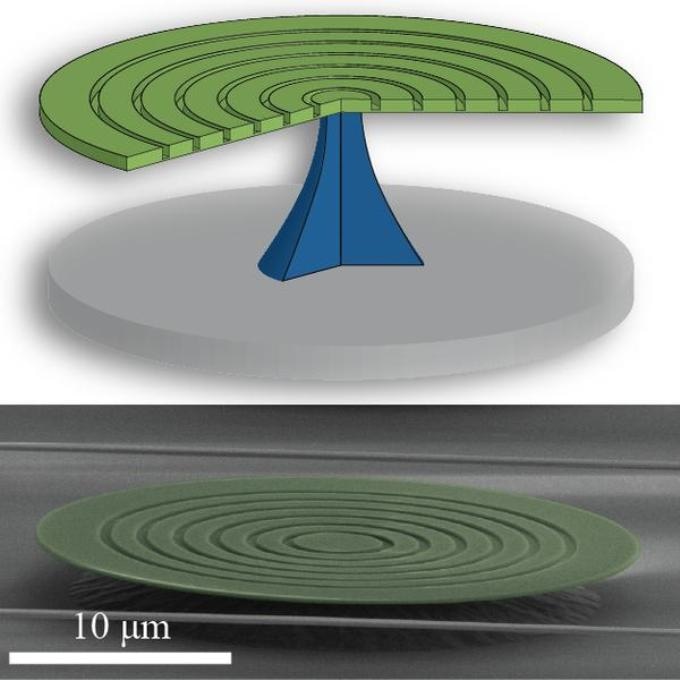Jan 10 2017
Researchers have developed a new type of optomechanical device that uses a microscopic silicon disk to confine optical and mechanical waves. The new device is highly customizable and compatible with commercial manufacturing processes, making it a practical solution for improving sensors that detect force and movement.
 Researchers created an optomechanical silicon bullseye disk that traps optical waves in the outermost ring via total internal reflection while the radial groves confine the mechanical waves to the same area. (Credit: Thiago P. Mayer Alegre, University of Campinas)
Researchers created an optomechanical silicon bullseye disk that traps optical waves in the outermost ring via total internal reflection while the radial groves confine the mechanical waves to the same area. (Credit: Thiago P. Mayer Alegre, University of Campinas)
Optomechanical devices use light to detect movement. They can be used as low-power, efficient building blocks for the accelerometers that detect the orientation and movement of a smart phone or that trigger a car’s airbag to deploy split seconds after an accident. Scientists are working to make these devices smaller and even more sensitive to movement, forces and vibrations.
Identifying the smallest movements requires extremely high levels of interaction, or coupling, between light waves, which are used for detection, and the mechanical waves that are tied to movement. In The Optical Society journal Optics Express, researchers from the University of Campinas, Brazil, report that their new bullseye disk design achieves coupling rates that match those of the best lab-based optomechanical devices reported.
While most state-of-the-art optomechanical devices are made using equipment that isn’t widely available, the new bullseye disk device was fabricated in a standard commercial foundry with the same processes used to manufacture complementary metal-oxide-semiconductor (CMOS) chips, such as the ones used in most digital cameras.
“Because the device was made at a commercial CMOS foundry, any group in the world could reproduce it,” said Thiago P. Mayer Alegre, leader of the research group. “If thousands were made, they would all perform in the same manner because we made them resilient to the foundry's fabrication processes. It is also much cheaper and faster to make these types of devices at a CMOS foundry rather than using specialized in-house fabrication techniques.”
Bringing light and motion together
Most optomechanical devices use the same mechanism to confine both the light and mechanical waves inside a material, where the waves can interact. However, this approach can limit the performance of optomechanical devices because only certain materials work well for confining both light and mechanical motion.
“Once you decouple the confinement rules for the light and mechanics, you can use any type of material,” said Alegre. “It is also makes it possible to independently tailor the device to work with certain light frequencies or mechanical wave frequencies.”
The researchers created a silicon disk 24 microns wide that confines the light and mechanical waves using separate mechanisms. The light is confined with total internal reflection, which causes the light to bounce off the edge of the disk and travel around the outer portion in a circular ring. The researchers added circular groves to the disc, giving it the appearance of a bullseye, to localize mechanical motion to the outer ring, where it can interact with the light. The disk is supported by a central pedestal that allows the disk to move.
“Radial groves have been used to confine light waves in other devices, but we took this idea and applied it to mechanical waves,” said Alegre. “Our optomechanical device is the first one to use radial groves to couple mechanical and optical waves.”
The versatility of the bullseye disk design means it could be used for more than sensing movement. For example, making the disk out of a lasing material could create a laser with pulses or power levels that are controlled by motion. The device could also be used to make very small and high frequency optical modulator for telecommunication applications.
The researchers are now working to further refine their device’s design to work even better with CMOS foundry fabrication processes. This should lessen the amount of light that is lost by the disk and thus improve overall performance. They also want to make the device even more practical by combining the optomechanical disk with an integrated optical waveguide that would bring light to and from the device, all in one package.